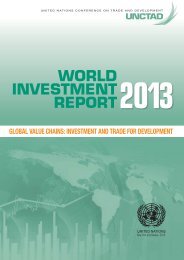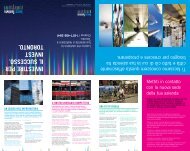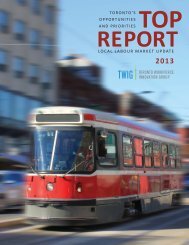challenges facing express delivery services in canada's urban centres
challenges facing express delivery services in canada's urban centres
challenges facing express delivery services in canada's urban centres
You also want an ePaper? Increase the reach of your titles
YUMPU automatically turns print PDFs into web optimized ePapers that Google loves.
Institute of Hous<strong>in</strong>g & Mobility<br />
Challenges <strong>fac<strong>in</strong>g</strong> the EDS <strong>in</strong>dustry <strong>in</strong> Canada's <strong>urban</strong> <strong>centres</strong><br />
TABLE 10: COMMERCIAL/COURIER ISSUES IN CANADIAN METROPOLITAN TRANSPORTATION PLANS<br />
City<br />
No. of Pages on<br />
Goods<br />
Movement<br />
% of Plan on<br />
Goods Movement<br />
Vancouver 3 5.4 No<br />
Calgary 2 3.3 No<br />
Edmonton 7 7.1 No<br />
W<strong>in</strong>nipeg 1 1.7 No<br />
Refers to ‘Couriers’<br />
‘Messengers’ or<br />
‘Express Delivery’?<br />
Hamilton 3 4.8 Yes (“air courier”)<br />
Toronto 2 1.8 Yes (“courier”)<br />
Ottawa 3 3.0 No<br />
Montreal 1 0.9 No<br />
The implication of this is that courier routes are not be<strong>in</strong>g acknowledged as priorities for<br />
improv<strong>in</strong>g access for goods movement. Instead, the plans <strong>in</strong>tend to restrict the types of uses that<br />
couriers require – a ready supply of street park<strong>in</strong>g and sufficient park<strong>in</strong>g times for deliver<strong>in</strong>g<br />
goods. Both of these requirements are currently be<strong>in</strong>g seen as <strong>urban</strong> traffic problems with little<br />
consideration of their importance for the efficient and timely <strong>delivery</strong> of 700 million packages <strong>in</strong><br />
Canada. It is also apparent that goods movement, <strong>in</strong> general, is not a major topic of<br />
transportation plans <strong>in</strong> Canada. With the exception of Vancouver, Edmonton, and Hamilton,<br />
discussions of goods movement issues never amount to more than 4 percent of transportation plan<br />
documents (Table 10).<br />
Conclusions from review of transport plans<br />
Based on the review of current municipal transport plans, we conclude that <strong>urban</strong> transportation<br />
policy <strong>in</strong> Canada’s major cities is mov<strong>in</strong>g towards restrict<strong>in</strong>g the availability of transportation<br />
required for a vigorous courier <strong>in</strong>dustry. For one, the place of courier <strong>services</strong> is rarely<br />
addressed <strong>in</strong> direct terms. This is probably on account of the lack of knowledge of the size and<br />
significance of courier <strong>services</strong> <strong>in</strong> commercial activity and the general vitality of cities.<br />
M<strong>in</strong>imal recognition is given the existence of courier operations, while at worst couriers are<br />
treated as an <strong>in</strong>convenience that should be expunged from congested central bus<strong>in</strong>ess districts.<br />
The few references that are made to courier-type transportation are focussed on controll<strong>in</strong>g and<br />
limit<strong>in</strong>g the activity. What is emphasised is a need to protect traffic flow and to limit deliveries to<br />
specific zones.<br />
Page 21
















![Creative City Planning Framework [PDF] - City of Toronto](https://img.yumpu.com/24270607/1/190x245/creative-city-planning-framework-pdf-city-of-toronto.jpg?quality=85)